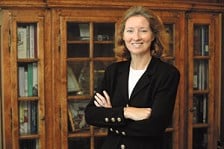She made it; top law director tells how

.bodytext {float: left; } .floatimg-left-hort { float:left; margin-top:10px; margin-right: 10px; width:300px; clear:left;} .floatimg-left-caption-hort { float:left; margin-bottom:10px; width:300px; margin-right:10px; clear:left;} .floatimg-left-vert { float:left; margin-top:10px; margin-right:15px; width:200px;} .floatimg-left-caption-vert { float:left; margin-right:10px; margin-bottom:10px; font-size: 10px; width:200px;} .floatimg-right-hort { float:right; margin-top:10px; margin-left:10px; margin-bottom:10px; width: 300px;} .floatimg-right-caption-hort { float:left; margin-right:10px; margin-bottom:10px; width: 300px; font-size: 10px; } .floatimg-right-vert { float:right; margin-top:10px; margin-left:10px; margin-bottom:10px; width: 200px;} .floatimg-right-caption-vert { float:left; margin-right:10px; margin-bottom:10px; width: 200px; font-size: 10px; } .floatimgright-sidebar { float:right; margin-top:10px; margin-left:10px; margin-bottom:10px; width: 200px; border-top-style: double; border-top-color: black; border-bottom-style: double; border-bottom-color: black;} .floatimgright-sidebar p { line-height: 115%; text-indent: 10px; } .floatimgright-sidebar h4 { font-variant:small-caps; } .pullquote { float:right; margin-top:10px; margin-left:10px; margin-bottom:10px; width: 150px; background: url(http://www.dmbusinessdaily.com/DAILY/editorial/extras/closequote.gif) no-repeat bottom right !important ; line-height: 150%; font-size: 125%; border-top: 1px solid; border-bottom: 1px solid;} .floatvidleft { float:left; margin-bottom:10px; width:325px; margin-right:10px; clear:left;} .floatvidright { float:right; margin-bottom:10px; width:325px; margin-right:10px; clear:left;} Marianne Short looks and acts the part of first woman in a prestigious position, genuine leader, someone who has it all by dint of amazing hard work, talent and, well, read on. …
The setting is Dorsey & Whitney in Minneapolis. This distinguished, global law firm has both former Vice President Walter Mondale and former Iowa Gov. Tom Vilsack on its roster. And here, as managing director, Short does more than hold her own. She leads. This firm with more than 640 lawyers and offices in 18 locations, including Des Moines, was founded in 1912, but it is startling in its modern thinking. Both she and her firm are leaders in corporate law, though she prefers to talk about the team rather than about herself.
So when Dorsey & Whitney was recently named one of the nation’s 50 best law firms for women by Working Mother magazine, she and the other women in top management at the firm were not surprised. And at a lunchtime meeting of Nexus, a group of professional women in Des Moines, she explained how it happened.
To determine what’s “best,” the magazine measured workforce profiles (the numbers of women, minority and male lawyers), benefits and compensation packages, parental leave policies, child care, flexibility and retention/advancement of women. Among these 50 firms, Dorsey & Whitney is the only one of the Am Law 100 (America’s 100 largest law firms by gross revenue) with a woman in the managing partner role. That would be Marianne Short.
Not surprisingly, the tall, attractive graduate of Boston College School of Law was involved in helping set up policies and programs to help lawyers create a balance between work and personal life. “This is important because it helps us retain and advance women,” she said.
“But let’s back up. We know there are not enough senior women leaders in law, and we also know it’s not about recruiting. You need to look at policies. You have to look at the path to partnership and then at the top positions open to both women and men. How many women are practice group leaders, office heads, on boards of directors and on management committees? In other words, how many women are involved in leadership roles?”
Law firms, known for long, punishing schedules for young associates, are often criticized for preventing any kind of balance between work and personal life. But Marianne Short has another story to tell. Exuding competence and confidence, she said she owes her good fortune to good luck, timing and excellent mentors. But she also said it all started at home, in the Minneapolis suburb of Edina where she and her six siblings – five of whom are lawyers – learned to hold their own during spirited dinner table conversations and competitive family ballgames.
Short also credits the all-girls Visitation Convent school in St. Paul, Minn., with providing her with role models and a carefully honed work ethic. “The nuns who taught us were quiet and refined, and we were defined by how well we accomplished every task, from setting a table to learning Latin.” Doing a good job was important, she emphasized, “not so you would shine, which was never a goal, but because of what your achievement contributed to the community.”
After this first-class beginning, she said her path to leadership was marked by decades of hard work. Work-life balance, she repeated several times during her presentation, does not mean less work. “Top female (and male) attorneys are strategic thinkers and hard-working. They’re significant thought leaders within their firms, are successful in their areas of expertise, feed others in the firm and bring in business. That’s what you need to do.”
The last is the hardest, she explained. “‘Rainmaking’ is difficult for young women because they tend to think of law as an intellectual challenge,” she said.”They don’t start careers thinking about partnering with clients. As you get more experienced, you think of solutions for others’ problems,” she said. “And this is key to bringing in business – problem solving for your friends. So our law firm helps junior lawyers see that helping others is what rainmaking is all about.”
Short stopped and asked a rhetorical question: “Why are we even talking about this today?” Because so few women are in leadership positions or in the senior ranks of major law firms. “We now realize that you can be at the top of your law school class, work very hard, be articulate and have the ability to develop strong relationships, but if you are not a rainmaker, you will not get to the highest level within the top law firms.”
To understand Short’s across-the-board achievements, it’s necessary to look at the practice of law in general. When Short joined Dorsey & Whitney in the ’70s, she worked the requisite hours that put young associate lawyers on the partnership track. Indeed, a recent action-packed day in Des Moines began on the first flight from the Twin Cities (she worked) and ended when she got home about 18 hours after her alarm clock rang. “Sure, it was a long day,” she said, “but I love being with my partners and thinking about business. You meet new people and keep shifting gears, and it keeps you thinking.”
However, conditions have changed since she graduated from law school in 1976. “The world we live in involves 24/7 service for clients,” she said. “But technology has changed everything, and having a flexible work schedule means you can spend time with your family and still be a good lawyer.”
Short told about a young woman lawyer at Dorsey & Whitney who worked at home when her children were small. “She started at 9 p.m. and worked until 4 a.m., which was fine for her and for us. When I started, we didn’t have our children’s pictures on our desks because we were afraid it might communicate a different priority. Today, when a female associate has a note on her door saying ‘do not disturb,’ I think she might be expressing milk for her baby.”
More than 30 years ago, Short and others at Dorsey & Whitney took a mind leap and set up flex-time policies and mentoring programs to help female attorneys and lawyers of color. They did this because “the more diverse we are, the broader the perspectives we bring to our work, and that’s good for everyone,” Short said. Programs have evolved. Today, every new lawyer is assigned a mentor. A marketing program exists to help lawyers learn to develop business. Money is even allocated for lunches where associates and partners meet and chat informally. And programs set up to help junior associates succeed are monitored. “But it’s also personal,” she explained. “We try to get the stories behind the numbers and encourage success for everyone.”
As for the best experience to prepare someone for law firm leadership, Short said quickly and with a laugh, “Motherhood. You have to be a juggler and know how to make peace. You sit down and listen carefully to all sides, and you may advise a timeout when your children need to think about compromise and how to make things work.” As a mother of two grown sons, she believes that good parents are peacemakers and compromisers. “You try to explain to your children that you want them to be a credit to those who are raising them,” she added.
The same principles apply to law firm management. “I was given wonderful opportunities by those who trained me, and I want to be a credit to them,” she said, adding that it’s a natural feeling to want to make your mentors proud of you. As for her job, it’s as much about strategizing as it is about management. Short helps evaluate opportunities for growth. “What is the right size for a major law firm today? How do we grow our business and how do we grow our number of lawyers? Those are the kinds of questions we need to answer,” she said.
In the meantime, is there any pushback – the feeling that too much time is devoted to women or diversity? “Not at all,” said Short. “Men care about work-life issues. Young men often have working wives, and we all want to do excellent work.” As for the key intangible quality for success, Short paused before she added: “To be a true leader, you have to have done the work better than others, so they will follow you. That’s the bottom line for young lawyers to understand.”







